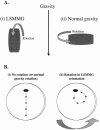Microbial responses to microgravity and other low-shear environments
- PMID: 15187188
- PMCID: PMC419922
- DOI: 10.1128/MMBR.68.2.345-361.2004
Microbial responses to microgravity and other low-shear environments
Abstract
Microbial adaptation to environmental stimuli is essential for survival. While several of these stimuli have been studied in detail, recent studies have demonstrated an important role for a novel environmental parameter in which microgravity and the low fluid shear dynamics associated with microgravity globally regulate microbial gene expression, physiology, and pathogenesis. In addition to analyzing fundamental questions about microbial responses to spaceflight, these studies have demonstrated important applications for microbial responses to a ground-based, low-shear stress environment similar to that encountered during spaceflight. Moreover, the low-shear growth environment sensed by microbes during microgravity of spaceflight and during ground-based microgravity analogue culture is relevant to those encountered during their natural life cycles on Earth. While no mechanism has been clearly defined to explain how the mechanical force of fluid shear transmits intracellular signals to microbial cells at the molecular level, the fact that cross talk exists between microbial signal transduction systems holds intriguing possibilities that future studies might reveal common mechanotransduction themes between these systems and those used to sense and respond to low-shear stress and changes in gravitation forces. The study of microbial mechanotransduction may identify common conserved mechanisms used by cells to perceive changes in mechanical and/or physical forces, and it has the potential to provide valuable insight for understanding mechanosensing mechanisms in higher organisms. This review summarizes recent and future research trends aimed at understanding the dynamic effects of changes in the mechanical forces that occur in microgravity and other low-shear environments on a wide variety of important microbial parameters.
Figures





References
-
- Alpatov, A., Y. Il'in, V. Antipov, and M. Tairbekov. 1988. Biological experiments on COSMOS-1887. Kosm. Biol. Aviakosm. Med. 23:26-32. - PubMed
-
- Audia, J. P., C. C. Webb, and J. W. Foster. 2001. Breaking through the acid barrier: an orchestrated response to proton stress by enteric bacteria. Int. J. Med. Microbiol. 291:97-106. - PubMed
-
- Berrier, C., M. Besnard, B. Ajouz, A. Coulombe, and A. Ghazi. 1996. Multiple mechanosensitive ion channels from Escherichia coli, activated at different thresholds of applied pressure. J. Membr. Biol. 151:175-187. - PubMed
-
- Berrier, C., A. Coulombe, C. Houssin, and A. Ghazi. 1989. A patch-clamp study of ion channels of inner and outer membranes and of contact zones of E. coli, fused into giant liposomes. Pressure-activated channels are localized in the inner membrane. FEBS Lett. 259:27-32. - PubMed
Publication types
MeSH terms
LinkOut - more resources
Full Text Sources
Other Literature Sources

